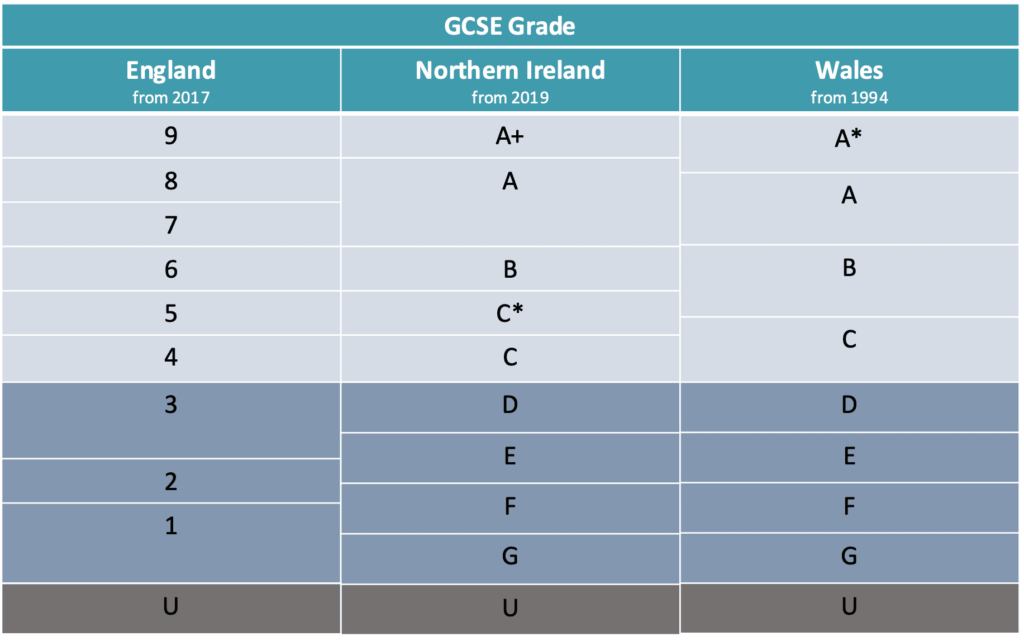To pursue your future education in the UK, It is important to understand how the school grading system works.
The grading system in the UK is unique the entire United Kingdom does not use the same grading scheme. Overall, the grading system applied in England, Wales and Northern Ireland share many similarities, while the Scottish grading system is different.
Table of Contents
Education System in the UK
The UK education system is divided into Four main stage, Primary Education, Secondary Education, Further Education and Higher Education. Education is compulsory for all children from age 5 and 16. Here is the UK Education System explained:

Grading System in the UK
Students will be assessed at the end of each education stage. Below is the overview of the three major grading systems of the UK education, and how it works.
Grading System in UK GCSE
The General Certificate of Secondary Education (GCSE) is a qualification generally taken by UK students in England, Wales and Northern Ireland at the end of secondary education. It usually takes two years, and students take the final exams when they’re 16. It also equivalent in Scotland is Standard Grade.
There are recent changes in the GCSE grading system in England, the 9-1 grading system was implemented. These subjects grades will be graded between 9-1, the highest grade is 9, while 1 is the lowest, not including a U (ungraded).
Meanwhile, the old GCSE grading system is still being used in Wales and Northern Ireland. Students are being graded by a letter grading system from A* (highest) to G (lowest), scores below a G will be marked as U for ‘ungraded’.
Here is the comparison of the grading system in GCSE

Grading System in UK A Level
The General Certificate of Education GCE Advanced Level (A Level) is a qualification for students aged 16 and above usually taken in the final two years of high school.
The final examinations will take place at the end of two years of classroom studies. Students can use this qualification to seek admission to higher education institutes in the UK.
Students are graded on a scale of A* (highest) to E (lowest) for A Level qualification. There is a U (unclassified) grade for those below the minimum standard required for a grade E.
The grading system in the UK for A Level as follows:
| Grade | Percentage Uniform Mark |
|---|---|
| A* | 90–100 |
| A | 80–89 |
| B | 70–79 |
| C | 60–69 |
| D | 50–59 |
| E | 40–49 |
Grading System in UK Undergraduate
There are two types of undergraduate degrees in the UK, the ordinary degree and the honours degree.
- The ordinary degree is the regular undergraduate degree. The most common examples are Bachelor of Science or BSc and Bachelor of Art or BA.
When students enrolled for an ordinary degree, they should aim to pass all the subjects and achieve a degree. If the student does not pass, he /she will not get a degree. - The honours degree is an undergraduate degree with honours. It commonly refers to a higher standard than an ordinary degree. The examples such as Bachelor of Science (Honours) or BSc (Hons) and Bachelor of Art (Honours) or BA (Hons).
When a student completed an honours degree, it not only specify whether a student has passed all the subjects but also highlights the performance level of the studies.
The table below shows the degree classifications for both degrees and their marks decryptions.
| Marks | Degree Classification | |
|---|---|---|
| Honours Degree | Ordinary Degree | |
| 70% and above | First-Class Honours (First or 1st) | Distinction |
| 60 - 69% | Upper Second-Class Honours (2:1) | Merit |
| 50 - 59% | Lower Second-Class Honours (2:2) | Pass |
| 40 - 49% | Third-Class Honours (Third or 3rd) | Pass |
| 0 - 39% | Fail | Fail |
UK Grading System vs. US Grading System
The UK and the US are the most popular study designation for international students to pursue their higher education. These two countries grading system are often be compared.
The table below shows the different these two countries university grading system.
| UK Grading | #colspan# | US Grading | |
|---|---|---|---|
| Marks | Honours Degree | Ordinary Degree | Grade |
| 80% and above | First-Class Honours (First or 1st) | Distinction | A+ |
| 70 - 79% | First-Class Honours (First or 1st) | Distinction | A |
| 65 - 69% | Upper Second-Class Honours (2:1) | Merit | A- |
| 60 - 64% | Upper Second-Class Honours (2:1) | Merit | B+ |
| 55 - 59% | Lower Second-Class Honours (2:2) | Pass | B |
| 50 - 54% | Lower Second-Class Honours (2:2) | Pass | B- |
| 46 - 49% | Third-Class Honours (Third or 3rd) | Pass | C+ |
| 43 - 45% | Third-Class Honours (Third or 3rd) | Pass | C |
| 40 - 42% | Third-Class Honours (Third or 3rd) | Pass | C- |
| 0 - 39% | Fail | Fail | F |








